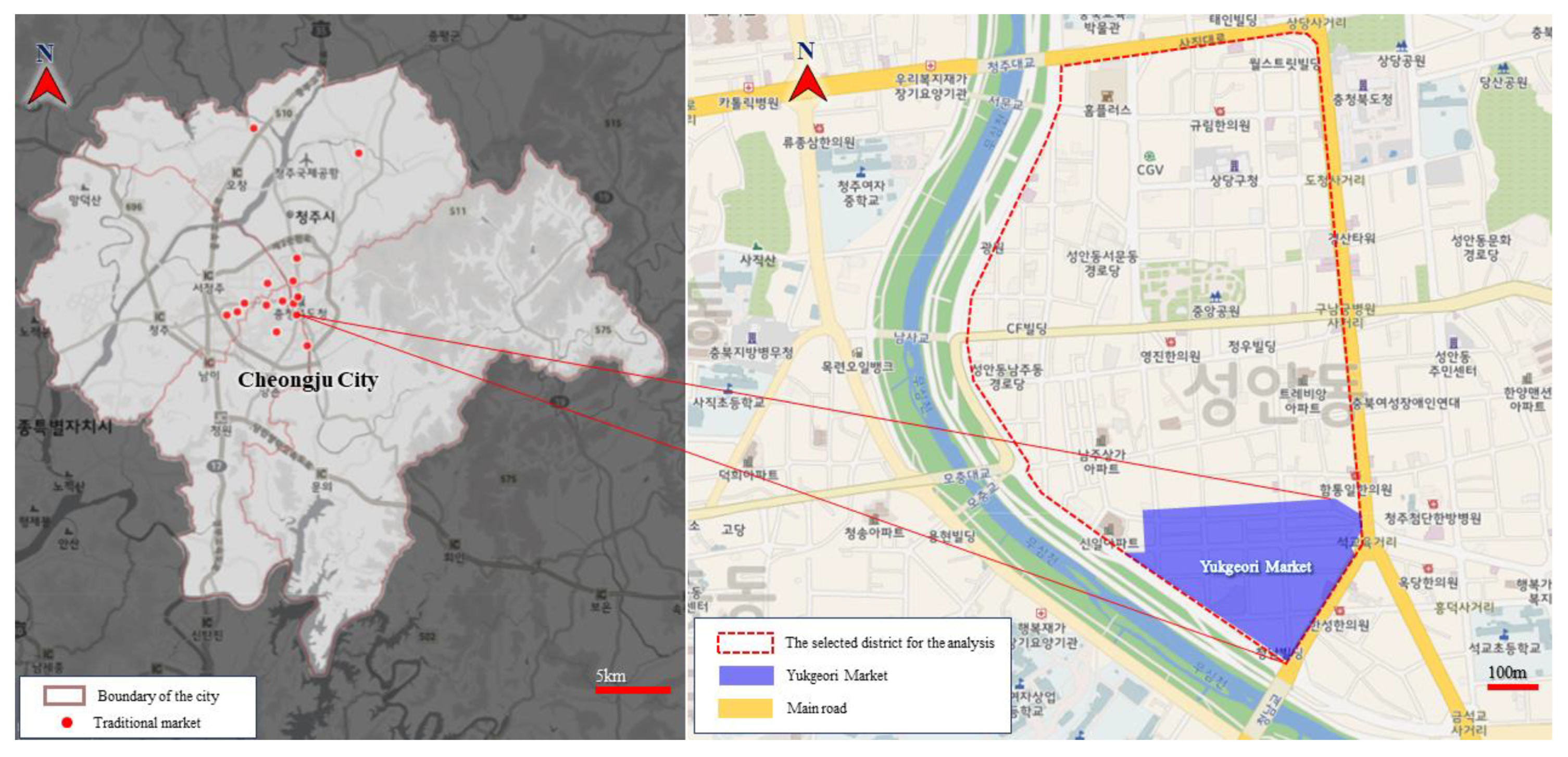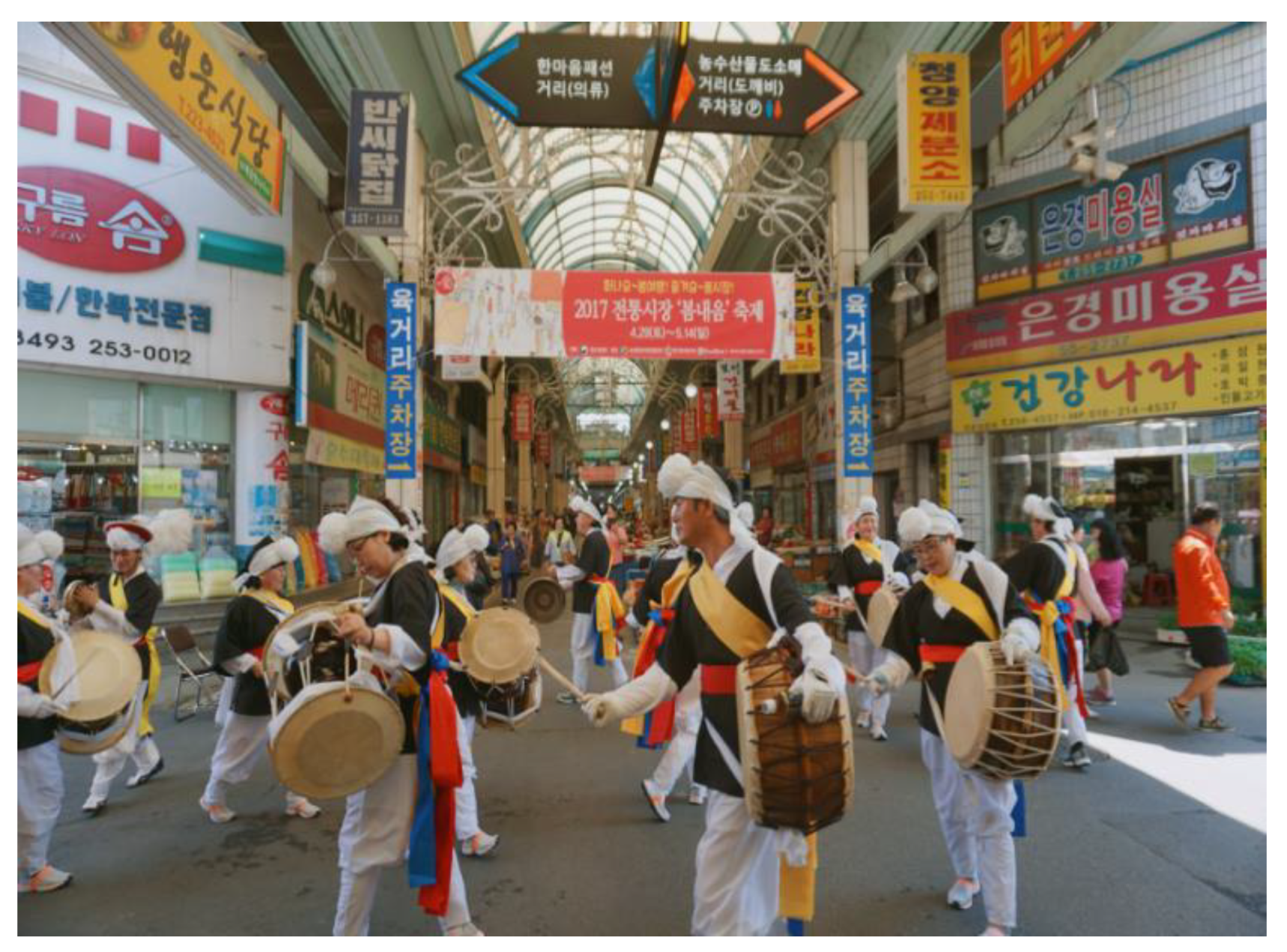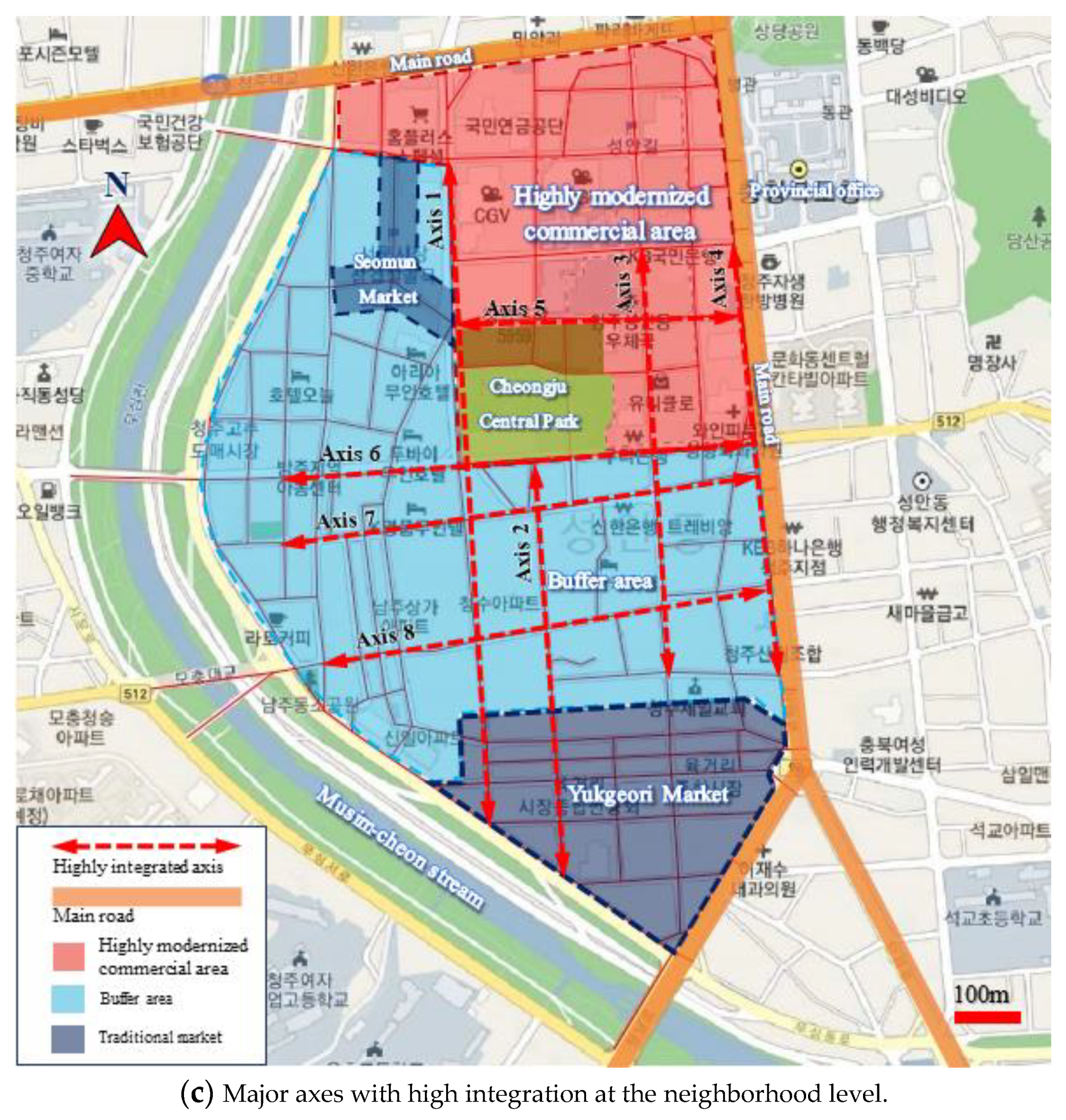Spatial Configurations for The Revitalization of a Traditional Market: The Case of Yukgeori Market in Cheongju, South Korea
Abstract
1. Introduction
2. The Characteristics of Korean Traditional Markets
3. Methods
3.1. Selection of The Research Area
3.2. The Construction of a Street Network for Spatial Analysis
3.3. Analytical Formula
4. Results of The Analysis
4.1. Basic Survey
4.2. Spatial Configuration Analysis Results
4.2.1. City-Level Analysis Results
4.2.2. Neighborhood-Level Analysis Results
5. Discussion
6. Conclusions
Author Contributions
Funding
Acknowledgments
Conflicts of Interest
References
- The Agency for Traditional Market Administration. White Paper on Traditional Market; The Agency for Traditional Market Administration: Daejeon, Korea, 2010. (In Korean) [Google Scholar]
- Ministry of Culture, Sports and Tourism (MCST). International Visitor Survey; MCST: Sejong, Korea, 2017. (In Korean)
- Thomas, C.J.; Bromley, R.D.F. Retail revitalization and small town centres: The contribution of shopping linkages. Appl. Geogr. 2003, 23, 47–71. [Google Scholar] [CrossRef]
- Upton, G.J.; Fingelton, B. Spatial Data Analysis by Example Volume 1: Point Pattern and Quantitative Data; John Wiley & Sons: New York, NY, USA, 1985; ISBN 978-04-7190-542-4. [Google Scholar]
- González, A.; Donnelly, A.; Jones, M.; Chrysoulakis, N.; Lopes, M. A decision-support system for sustainable urban metabolism in Europe. Environ. Impact Assess. 2012, 38, 109–119. [Google Scholar] [CrossRef]
- Reilly, W.J. The Law of Retail Gravitation; Knickerbocker Press: New York, NY, USA, 1931. [Google Scholar]
- Hillier, B. Space is the Machine: A Configurational Theory of Architecture; Cambridge University Press: Cambridge, UK, 1996; ISBN 978-05-2156-039-9. [Google Scholar]
- Hillier, B.; Hanson, J. The Social Logic of Space; Cambridge University Press: Cambridge, UK, 1984; ISBN 978-05-2123-365-1. [Google Scholar]
- Batty, M. The New Science of Cities; MIT Press: Cambridge, MA, USA, 2013; ISBN 978-02-6201-952-1. [Google Scholar]
- Jiang, B.; Claramunt, C. A structure approach to the model generalization of an urban street network. GeoInfomatica 2004, 8, 157–171. [Google Scholar] [CrossRef]
- Osman, K.M.; Suliman, M. The space syntax methodology: Fits and misfits. Arch. Behav. 1994, 10, 189–204. [Google Scholar]
- Rao, F.; Dovey, K.; Pafka, E. Towards a genealogy of urban shopping: Types, adaptations and resilience. J. Urban Des. 2018, 23, 544–557. [Google Scholar] [CrossRef]
- Wrigley, N.; Dolega, L. Resilience, fragility, and adaptation: New evidence on the performance of UK high streets during global economic crisis and its policy implications. Environ. Plan. A 2011, 43, 2337–2363. [Google Scholar] [CrossRef]
- Itzhak, O.; Ran, G. Spatail patterns of retail activity and street network structure in new and traditional Islaeli cities. Urban Geogr. 2016, 37, 629–649. [Google Scholar] [CrossRef]
- Ministry of Government Legislation (MOLEG). Special Act on the Development of Traditional Markets and Shopping Districts; MOLEG: Sejong, Korea, 2018.
- MOLEG. Enforcement Decree of the Special Act on the Development of Traditional Markets and Shopping Districts; MOLEG: Sejong, Korea, 2018.
- The City Hall of Seoul. The Modernization Plan of Namdaemun Market; The City Hall of Seoul: Seoul, Korea, 1968. (In Korean) [Google Scholar]
- Seoul Museum of History. Namdaemun Market; Seoul Museum of History: Seoul, Korea, 2014; ISBN 979-11-8632-449-3. (In Korean) [Google Scholar]
- Park, Y.G. The Opening of Retail Market (1991); National Archives of Korea: Daejeon, Korea, 2007. Available online: http://www.archives.go.kr/next/search/listSubjectDescription.do?id=007 (accessed on 1 March 2017). (In Korean)
- Kim, K.J. Turbulent Retail Market. Maeil Business News Korea. 5 June 1996, p. 18. Available online: https://www.mk.co.kr/news/economy/view/1996/06/26255/ (accessed on 1 March 2017). (In Korean).
- Jeong, H.H. Retailing Industry Trends in 1995—Traditional Markets Have Suffered from a Recession throughout the Year. Maeil Business News Korea. 15 December 1995, p. 16. Available online: https://www.mk.co.kr/news/economy/view/1995/12/57463/ (accessed on 1 March 2017). (In Korean).
- MOLEG. Special Act on the Nurturing of Traditional Markets; MOLEG: Seoul, Korea, 2005.
- Guy, C.M. Classifications of retail stores and shopping centres: Some methodological issues. GeoJournal 1998, 45, 255–264. [Google Scholar] [CrossRef]
- Lowe, M. The regional shopping centre in the inner city: A study of retail-led urban regeneration. Urban Stud. 2005, 42, 449–470. [Google Scholar] [CrossRef]
- Gibbs, R.J. Principles of Urban Retail Planning and Development; John Wiley & Sons: Hoboken, NJ, USA, 2012; ISBN 978-04-7048-822-5. [Google Scholar]
- Lee, S.H. Korea Tourism Organization (KTO) Releases list of 16 traditional markets for tourists. BusinessKorea News. 15 May 2015. Available online: http://www.businesskorea.co.kr/news/articleView.html?idxno=10577 (accessed on 1 March 2017).
- MCST. The Ministry of Cultures, Sports and Tourism and the Korea Tourism Organization Selected the Best 20 Korean Traditional Markets of 2018; MCST: Sejong, Korea, 2018. (In Korean)
- MOLEG. Enforcement Rules of the Special Act on the Development of Traditional Markets and Shopping Districts; MOLEG: Sejong, Korea, 2017.
- Small and Medium Business Administration (SMBA) Press Release. SMBA Signed a Business Agreement with the Korea Tourism Organization to promote the Globalization of Traditional Markets. 10 July 2015. Available online: https://www.mss.go.kr/site/smba/ex/bbs/View.do?cbIdx=86&bcIdx=51807&parentSeq=0 (accessed on 1 March 2017). (In Korean).
- Hillier, B.; Iida, S. Network and psychological effects in urban movement. In Proceedings of Spatial Information Theory: International Conference (COSIT 2005); Cohn, A.G., Mark, D.M., Eds.; Springer: Berlin, Germany, 2005; pp. 475–490. [Google Scholar]
- Can, I.; Heath, T. In-between spaces and social interaction: A morphological analysis of Izmir using space syntax. J. Hous. Built Environ. 2016, 31, 31–49. [Google Scholar] [CrossRef]
- Turner, A. Angular analysis. In Proceedings of the 3rd International Symposium on Space Syntax, Atlanta, USA, 7–11 May 2001; pp. 30.1–30.11. [Google Scholar]
- Space Syntax Network. DepthmapX; Space Syntax Limited: London, UK, 2013; Available online: https://www.spacesyntax.net/software/ (accessed on 1 April 2017).
- Jiang, B.; Claramunt, C. Integration of space syntax into GIS: New perspectives for urban morphology. Trans. GIS 2002, 6, 295–309. [Google Scholar] [CrossRef]
- Jeong, S.K.; Ban, Y.U. A point-based angular analysis model for identifying attributes of spaces at nodes in street networks. Phys. A Stat. Mech. Appl. 2016, 450, 71–84. [Google Scholar] [CrossRef]
- Rao, F. Resilient Forms of shopping centers amid the rise of online retailing: Towards the urban experience. Sustainability 2019, 11, 3999. [Google Scholar] [CrossRef]
- Chungcheongbuk-do, Traditional Markets in Chungcheongbuk-do; Chungcheongbuk-do Provincial Offices: Cheongju, Korea, 2019. (In Korean)
- The Academy of Korean Studies. The Digital Local Culture Encyclopedia of Korea. 2012. Available online: http://www.grandculture.net/ko/Contents/MediaPop?contents_id=GC00201054&media_id=GC002P1296&nowNum=1 (accessed on 1 March 2017). (In Korean).
- Pafka, E. Integration is not Walkability: The limits of axial topological analysis at neighbourhood scale. In Proceedings of the 11th Space Syntax Symposium, Lisbon, Portugal, 3–7 July 2017; Heitor, T., Serra, M., Silva, J.P., Bacharel, M., Silva, L.C., Eds.; Instituto Superior Técnico: Lisbon, Portugal, 2017; pp. 102.1–102.10. [Google Scholar]
- Lamíquiz, P.J.; López-Domínguez, J. Effects of built environment on walking at the neighbourhood scale. A new role for street networks by modelling their configurational accessibility? Transp. Res. Part A Policy Pract. 2015, 74, 148–163. [Google Scholar] [CrossRef]
- Netto, V.M. ‘What is space syntax not?’ Reflections on space syntax as sociospatial theory. Urban Des. Int. 2016, 21, 25–40. [Google Scholar] [CrossRef]
- Kim, J.I.; Lee, C.M.; Ahn, K.H. Dongdaemun, a traditional market place wearing a modern suit: The importance of the social fabric in physical redevelopments. Habitat Int. 2004, 28, 143–161. [Google Scholar] [CrossRef]
- Talen, E.; Jeong, H. What is the value of ‘main street’? Framing and testing the arguments. Cites 2019, 92, 208–218. [Google Scholar] [CrossRef]
- Hipp, J.A.; Bird, A.; van Bakergem, M.; Yarnall, E. Moving targets: Promoting physical activity in public spaces via open streets in the US. Prev. Med. 2016, 103, S15–S20. [Google Scholar] [CrossRef]
- Chaudhuri, A.; Zieff, S.G. Do open streets initiatives impact local businesses? The case of Sunday Streets in San Francisco, California. J. Transp. Health 2015, 2, 529–539. [Google Scholar] [CrossRef]
- Chang, J.; Min, J.; Lin, Y.; Chiang, C.H. Profiling Japanese tourists visiting night markets in Taiwan. J. Qual. Assur. Hosp. Tour. 2007, 8, 25–44. [Google Scholar] [CrossRef]
- Hillier, B. Centrality as a process: Accounting for attraction inequalities in deformed grids. Urban Des. Int. 1999, 4, 107–127. [Google Scholar] [CrossRef]
- Frank, L.D.; Sallis, J.F.; Conway, T.L.; Chapman, J.; Saelens, B.E.; Backman, W. Many pathways from land use to health: Associations between neighborhood walkability and active transportation, body mass index, and air quality. J. Am. Plann. Assoc. 2006, 72, 75–87. [Google Scholar] [CrossRef]
- Penn, A.; Turner, A. Movement-generated land-use agglomeration: Simulation experiments on the drivers of fine-scale land-use patterning. Urban Des. Int. 2004, 9, 81–96. [Google Scholar] [CrossRef]
- Turner, L.; Reisinger, Y. Shopping satisfaction for domestic tourists. J. Retail. Consum. Serv. 2001, 8, 15–27. [Google Scholar] [CrossRef]





| Categories | Traditional Markets | Modern Markets |
|---|---|---|
| Formation method | Formed in an unplanned manner. | Formed in a planned manner. |
| Ownership | Ownership is fragmented. | In the case of the big box store, ownership is usually single and private. |
| Spatial form | Most are in the form of street markets with many small buildings while the upper part of the street is often covered by a canopy. | Most are built in the form of a street market or big box store. |
| Shoppers’ passage | Usually, shoppers’ passages are narrow. | Shoppers’ passages are wider and more spacious than those of the traditional market. |
| Price of products | Negotiable. | Predetermined. |
| Street vendors | Many street vendors do business on the sidewalks at the market boundaries. | Strong controls and surveillance prevent street vendors from doing business around the market. |
| Market Name | Number of Stores | Land Area (m2) | Market Size | Store Placement Type |
|---|---|---|---|---|
| Gagyeong Terminal | 85 | 8389 | Small | Street-facing and street vendor |
| Naedeok-jayon | 52 | 9395 | Small | Street-facing |
| Naesu | 76 | 6912 | Small | Street-facing and street vendor |
| Dukkeobi | 59 | 6816 | Small | Street-facing and street vendor |
| Bokdae | 55 | 7843 | Small | Street-facing and street vendor |
| Bokdae-gagyeong | 77 | 8000 | Small | Street-facing and street vendor |
| Bukbu | 133 | 10,296 | Medium | Street-facing and street vendor |
| Sajik | 71 | 10,735 | Small | Street-facing, street vendor and accommodation in a building |
| Seomun | 73 | 15,269 | Small | Street-facing |
| Ochang | 71 | 35,784 | Small | Street-facing |
| Wonmaru | 103 | 7968 | Medium | Street-facing |
| Yukgeori | 1202 | 45,433 | Large | Street-facing and street vendor |
| Joongang | 62 | 4380 | Small | Street-facing and accommodation in a building |
| Jikji | 60 | 5640 | Small | Street-facing |
| Sachang | 103 | 5109 | Medium | Street-facing and street vendor |
| Categories | Contents | |||||||
|---|---|---|---|---|---|---|---|---|
| Sale Item | Agricultural Foods | Livestock Foods | Aquatic Foods | Processed Foods | Clothing and Shoes | Housewares | Restaurant Foods | Others |
| Number of stores (Percentage) | 420 (35%) | 120 (10%) | 300 (25%) | 84 (7%) | 36 (3%) | 120 (10%) | 60 (5%) | 60 (5%) |
| Spatial Configuration | Land-Use Pattern |
|---|---|
| The intersection of the roads leading to all areas of the city | Use as a traffic junction The concentration of commercial functions |
| Adjacent to a bridge connecting eastern and western areas of the city, which are separated by a long stream | Connection of two separated areas The concentration of commercial functions |
| Location | Axis | MD (Average) | Spatial Configuration | Land-use Pattern |
|---|---|---|---|---|
| The market and its vicinity | Axis 1 | 6.22~7.87 (7.13) | Long street passing through a highly modernized commercial area, buffer area, and the traditional market | Activation of commercial business functions along the street |
| Axis 2 | 6.30~7.92 (6.99) | |||
| Axis 3 | 6.29~7.77 (6.78) | |||
| The boundary of the district | Axis 4 | 6.32~7.99 (6.92) | The boundary of the district where bus stops are continuously arranged along the main road | Operation of public transport on the axis |
| The modernized area | Axis 5 | 6.70~7.77 (7.02) | Inside the modernized area, the east–west road that meets three long north–south streets (axes 1, 3 and 4) | Used as an access road to the large parking lot located at the center of the district |
| The boundary between the modernized area and the buffer area | Axis 6 | 6.19~7.61 (6.59) | On the boundary between the modernized area and the buffer area, the long east–west street intersecting three north–south axes mentioned above (axes 1, 3 and 4) | Used as a specialized street filled with many stores selling mainly wedding gifts |
| The buffer area | Axis 7 | 6.30~7.58 (6.78) | Inside the buffer area, the long east–west street intersecting four north–south axes mentioned above (axes 1 to 4) | Used as a specialized street filled with many stores selling mainly hanbok, the traditional clothing of Korea |
| The buffer area | Axis 8 | 6.33~7.52 (6.79) | Inside the buffer area, the long east–west street intersecting four north–south axes mentioned above (axes 1 to 4) | Used as a specialized street filled with many stores selling various types of furniture |
© 2020 by the authors. Licensee MDPI, Basel, Switzerland. This article is an open access article distributed under the terms and conditions of the Creative Commons Attribution (CC BY) license (http://creativecommons.org/licenses/by/4.0/).
Share and Cite
Jeong, S.K.; Ban, Y.U. Spatial Configurations for The Revitalization of a Traditional Market: The Case of Yukgeori Market in Cheongju, South Korea. Sustainability 2020, 12, 2937. https://doi.org/10.3390/su12072937
Jeong SK, Ban YU. Spatial Configurations for The Revitalization of a Traditional Market: The Case of Yukgeori Market in Cheongju, South Korea. Sustainability. 2020; 12(7):2937. https://doi.org/10.3390/su12072937
Chicago/Turabian StyleJeong, Sang Kyu, and Yong Un Ban. 2020. "Spatial Configurations for The Revitalization of a Traditional Market: The Case of Yukgeori Market in Cheongju, South Korea" Sustainability 12, no. 7: 2937. https://doi.org/10.3390/su12072937
APA StyleJeong, S. K., & Ban, Y. U. (2020). Spatial Configurations for The Revitalization of a Traditional Market: The Case of Yukgeori Market in Cheongju, South Korea. Sustainability, 12(7), 2937. https://doi.org/10.3390/su12072937




